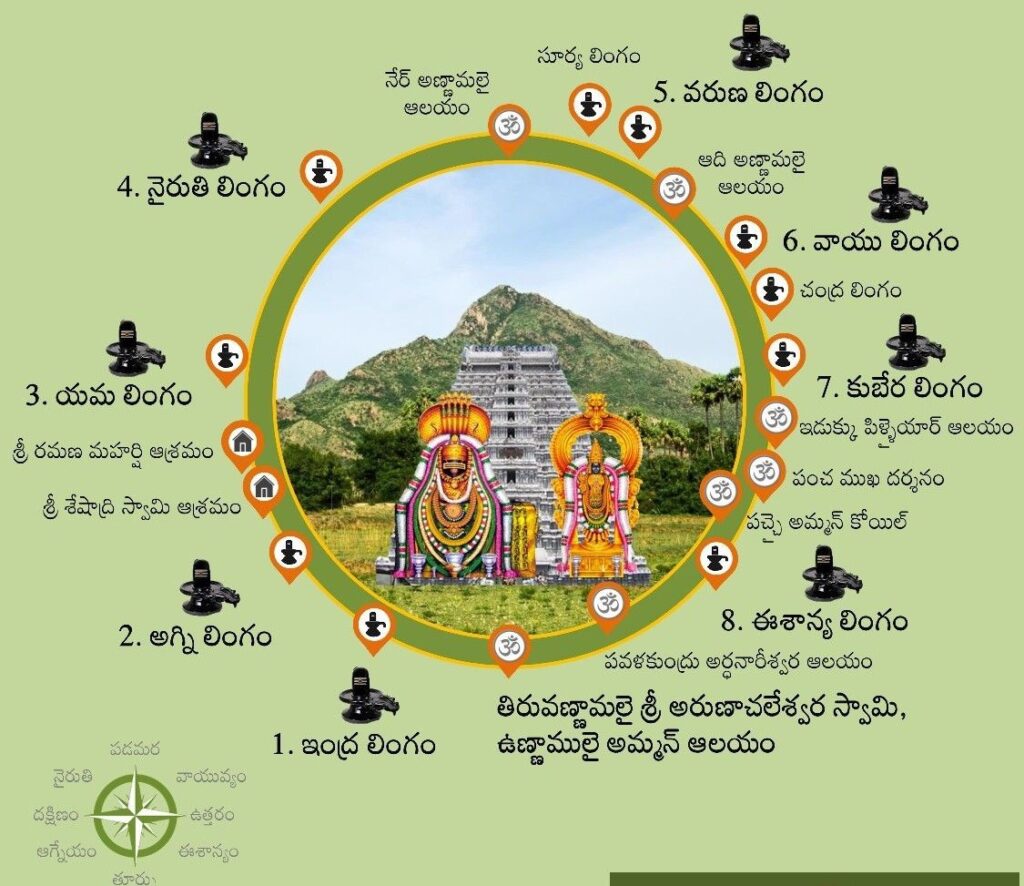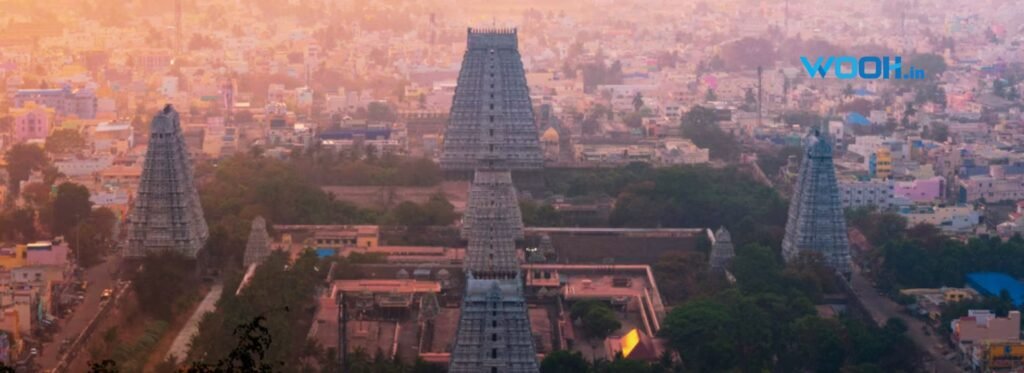Dedicated to the Hindu god Shiva, the Arunachalesvara Temple (also known as Annamalaiyar Temple) is situated in the Tamil Nadu town of Tiruvannamalai at the foot of Arunachala Hill. As one of the temples connected to the five elements, the Pancha Bhuta Sthalams, and particularly the element of fire, or Agni, it holds special significance for the Hindu Shaivism sect.
Shiva is known as Agni lingam, and he is revered as Arunachalesvara or Annamalaiyar. Shiva is symbolized as a lingam. Parvati, his consort, is shown as either Apithakucha Ambal or Unnamalai Amman.The Tevaram, a 7th-century Tamil Saiva canonical poem composed by Tamil saint poets known as nayanars and categorized as Paadal Petra Sthalam, honors the presiding deity. The Tiruvempavai was written here by the Shaiva saint poet Manikkavasagar in the ninth century.
One of the biggest temple complexes in India, it spans 10 hectares.Four gopurams, or gateway towers, are located there. With eleven floors and a height of 66 meters (217 feet), the eastern tower is the highest and one of the tallest temple towers in India. It was constructed by Sevappa Nayakkar of the Nayakar dynasty. The most well-known of the temple’s many shrines are those of Arunachalesvara and Unnamalai Amman. Among the numerous halls within the temple complex is the hall with a thousand pillars, which dates back to the Vijayanagara era.
The current masonry construction dates back to the Chola dynasty in the ninth century. Vijayanagara monarchs of the Sangama (1336–1485 CE), Saluva (1336–1485 CE), and Tuluva (1491–1570 CE) dynasties are credited with later extensions. The Tamil Nadu government’s Hindu Religious and Charitable Endowments Department is in charge of overseeing and maintaining the temple.
The temple schedules twelve annual festivals in addition to six daily rituals that take place between 5:30 a.m. and 10 p.m. On the full moon day in November or December, the Karthikai Deepam celebration is held, and a massive beacon is lit atop the hill. Visible for kilometers, it represents the Shiva lingam of fire uniting with the sky. Three million pilgrims watch the occasion. A million pilgrims do Girivalam, a form of worship that involves circumnavigating the temple base and the Arunachala hills on the day before each full moon.
Through the writings of Ramana Maharishi (1879–1950 CE), the western world became aware of Tiruvannamalai in the middle of the 20th century.

Story
The Annamalai hills in the foreground, with temple towers According to Hindu mythology, Parvati, the wife of Shiva, once playfully closed her husband’s eyes when they were in their home atop Mount Kailash in a flower garden. It lasted only a second for the gods, but for years afterward, the world was plunged into complete darkness as all light was removed from the universe. Parvati and other Shiva followers carried out penance.The earth was once again illuminated by her husband’s appearance as a massive column of fire at the summit of the Annamalai hills. After that, he united with Parvati to become Ardhanarishvara, Shiva’s half-male, half-female form.Behind the Arunachalesvara temple is the Arunachala, also known as the red mountain, which is connected to the temple of the same name. The hill is revered and regarded as a lingam, or a recognizable image of Shiva.
Another mythology states that Shiva once manifested as a flame and challenged Vishnu and Brahma to locate his source when they were fighting for supremacy. Vishnu assumed the form of the boar Varaha and went in search of the flame’s base, while Brahma transformed into a swan and flew to the sky to witness the flame’s summit.In most Shiva temples, the scene known as Lingodbhava is depicted on the western wall of the shrine. Neither Vishnu nor Brahma were able to locate the source.
History
Ancient Tamil writers have mentioned the shrine at Annamalai and the presiding deity, including Nakkirar (c. 1st century BCE to 1st century CE), Kapilar, and Paranar (c. 125–225 CE). The temple was mentioned in the poetry Tevaram by the Nayanar saints Sambandar and Appar in the seventh century. The Periyapuranam’s author, Sekkizhar, stated that Arunachalesvara was worshipped in the temple by both Appar and Sambandar. Temples were favored by the Chola Kings, who dominated the area for nearly four centuries, from 850 to 1280 CE. The Chola king’s inscriptions document several gifts to the temple, including land, sheep, cows, and oil, in remembrance of the dynasty’s achievements.Starting in 1328 CE, Tiruvannamalai served as the capital of the Hoysala monarchs. 48 are present. 55 inscriptions from the Tuluva Dynasty, 2 inscriptions from the Saluva Dynasty, and inscriptions from the Sangama Dynasty (1336–1485 CE)
Inscriptions from the reign of the most powerful Vijayanagara ruler, Krishnadeva Raya (1509–1529 CE), are also present, suggesting additional patronage.[19] While some were written in Kannada and Sanskrit, Tamil made up the majority of the Vijayanagara inscriptions.[20] In contrast to the inscriptions of the same monarchs in other temples, such as Tirupathi, the Vijayanagara kings’ temples show an emphasis on administrative problems and local concerns. Land endowments account up the majority of the gift-related inscriptions, followed by items, financial endowments, cows, and oil for lighting lights.[19] During the Vijayanagara Empire, Tiruvannamalai was strategically located at a crossroads that connected military routes and holy sites of pilgrimage.[21] Inscriptions from before the precolonial era depict the region as an urban hub, with the city developing around the temple.
Festivals and worship
The temple and the town of Tiruvannamalai were ruled by the Nawab of the Carnatic during the 17th century CE. Following 1753, there was confusion and disorder in the town as the Nawab lost power when the Mughal empire came to an end. The temple also experienced periods of both Hindu and Muslim guardianship, with successive sieges by Burkat Ullakhan, Mrithis Ali Khan, Krishna Raya, and Muraru Raya. As European raids continued, French Soupries, Sambrinet, and English Captain Stephen Smith all launched attacks on Tiruvannamalai. Some were defeated, but others triumphed. The town was taken over by the French in 1757, and the British took over both the town and the temple in 1760. The Tippu Sultan (1782–1799 CE) took control of Tiruvannamalai town in 1790 CE.The town and the temple were governed by the British during the first part of the 1800s. The Hindu Religious and Charitable Endowments Department (HR & CE) of the Tamil Nadu government has been in charge of maintaining the temple since 1951 in accordance with the terms of the Hindu Religious and Charitable Endowments Act. The Archaeological Survey of India assumed responsibility for the temple’s maintenance and designation as a national historic monument in 2002. The Archaeological Survey was forced to return the temple to the Hindu Religious and Endowment Board, nevertheless, as a result of widespread demonstrations and legal disputes with the Indian Supreme Court.
Poojas, or rituals, are carried out by temple priests both on a daily and festival basis. The priests at this temple are Shaivaite Brahmins, just like at other Shiva temples in Tamil Nadu. The pandit conducts the temple rites six times a day: at 5:30 a.m. for Ushatkalam, 8:00 a.m. for Kalashanti, 10:00 a.m. for Uchikalam, 6:00 p.m. for Sayarakshai, 8:00 p.m. for Irandamkalam, and 10:00 p.m. for Arddha Jamam. For both Arunachaleshvara and Unnamulai Amman, the ceremony consists of four steps: abhishekam (holy bath), alankaram (decoration), naivedyam (food offering), and deepa aradhanai (waving of lamps). Priests recite passages from the Vedas as part of the ritual, while worshipers prostrate themselves in front of the temple mast. Music is provided by the nagaswaram and tavil percussion instruments. There exist monthly celebrations such as amavasai (new moon day), kruttika, purnima (full moon day), and chaturthi, as well as weekly rituals like somavaram and sukravaram and fortnightly rituals like pradosham.
The temple holds numerous festivities all year round. The Brahmotsavam is one of four major festivals that is observed annually. The most significant of them takes place over the course of 10 days in November and December, during the Tamil month of Karthikai, and ends with the celebration of Karthikai Deepam. During the Deepam, a massive light is ignited in a cauldron filled with three tons of ghee at the summit of the Arunachala hills.The festival picture of Arunachalesvara is captured around the mountain’s wooden chariot to commemorate the event. The event was extended to ten days in the twentieth century, but it was celebrated as early as the Chola period (c. 850–1280 CE), according to inscriptions.
Tens of thousands of pilgrims circumambulate the Arunachala hill in bare feet as a form of prayer for Arunachalesvara every full moon. Known as Girivalam, the circumambulation is 14 kilometers (8.7 miles) long. Hindu mythology claims that the walk atones for misdeeds, grants wishes, and aids in breaking away from the cycle of birth and rebirth. A series of tanks, shrines, pillared meditation halls, springs, and caverns surround the hill where offerings are made. Throughout the remainder of the month, the circumambulation is maintained. Hundreds of thousands of pilgrims travel from all over the world to worship Arunachalesvara on the day of the annual Chitra Pournami, the full moon in the Tamil calendar. For the procession, five temple carriages with wooden sculptures, known as ther, are utilized.
Another celebration, Tiruvoodal, is observed annually in the middle of January, during the first week of the Tamil month of Thai. Between January 15 and 16, on the morning of Maatu Pongal, Nandi is adorned with garlands made of fruits, vegetables, and candies. To act out the evening oodal (or love dispute) between Arunachalesvara and Unnamamulai Amman, the festival deities are brought from the temple to Tiruoodal street.
Distance from Tirupati to Arunachalam: 190 km
heading from Tirupati to Arunachalam, but they are unsure of how far apart they are. Thus, you’ve arrived to the appropriate spot today. Because we’ll be telling you the locations of Tirupati and Arunachalam, as well as their respective distances, in today’s article. In addition, how many hours would it take you to get between the two? So let’s get started and investigate.
First, allow us to introduce you to both locations. Speaking of Tirupati, it is one of the most well-known pilgrimage sites in India and is situated in the Andhra Pradesh district of tirupathi. Millions of people visit this place primarily to see the temple of Lord Venkateswara, which is situated on the Tirumala mountain at an elevation of roughly 3200 feet above sea level. Arunachalam is also known as Arunachaleshwar. In the Indian state of Tamil Nadu, there is a well-known temple devoted to Lord Shiva. Thousands of worshippers also travel here to pay their respects, and if we consider the distance between Tirupati and Arunachalam Temple, or Arunachaleshwar, it is 190 kilometers.
Timings for Arunachalam Temple:
5:00 am Temple opening Hours
5:15 am Gomatha Pooja
5:30 am Palli Ezhuchi Pooja
6:00 am Ushakala Pooja
8:30 am Kalasanthi Pooja
11:00 am Uchi Kala Pooja
12:30 pm Temple closing Hours
12:30 pm – 3:30 pm Temple remains closed
3:30 pm Temple reopens
5:30 pm Sayaratchai Pooja
7:30 pm 2nd Kala Pooja
9:00 pm Arthajama Pooja
9:15 pm Palliarai Pooja
9:30 pm Temple closing Hours
How to reach Arunachalam Temple?
Temple is located 207 km from Chennai and can be reached in 3 hours 45 minutes by car and 4 hours 30 minutes by bus.
There are trains from Chennai to Thiruvannamalai every day. On this day, special trains will be available.
Thiruvannamalai has excellent connections throughout Tamil Nadu.
arunachalam temple giri pradakshina distance
Girivalam, also known as Giri Pradakshina, is the path that circles the sacred hill Arunachala. The Arunachaleshwara Swami Temple is surrounded by a 14-kilometer path, and walking barefoot around the sacred hill in pradakshina is said to atone for all sins. On the day of the full moon, thousands of devotees engage in this holy pradakshina in order to receive Lord Arunachala’s blessings. Around the sacred hill are eight tiny shrines dedicated to Ashtalingams.
arunachalam temple online room booking
Hotels near Arunachaleswara Temple in Thiruvannamalai: Use MakeMyTrip to find the best deals on hotels near Arunachaleswara Temple.
Find the Best Offers on Hotels in Thiruvannamalai Near Arunachaleswara Temple. Choose from 31 Hotels in the vicinity of Arunachaleswara Temple.✔ Check the rates and reserve a hotel near the Arunachaleswara Temple to receive up to 70% off. Explore Thiruvannamalai Hotels Easily on www.goibibo.com, Our Partner Website
relevance for religion
One of the Pancha Bhoota Stalams, or five Shiva temples, is the Arunachalesvara temple. The other four are the sky, fire, water, and earth.Shiva is reported to have appeared in the Arunachalesvara temple as a huge column of fire, whose feet and crown the Hindu deities Brahma and Vishnu were unable to locate. The Agni Lingam, the primary lingam in the shrine, symbolizes responsibility, virtue, selflessness, and release via an austere lifestyle at the conclusion of the Agni kalpa.
Shiva temples known as Aathara Stala are thought to represent the Tantric chakras in the human body. The Manipooraga (Manipura) chakra is connected to the Arunachalesvara temple, also known as the Manipooraga stalam . The manipooraga chakra associated with the solar plexus.


